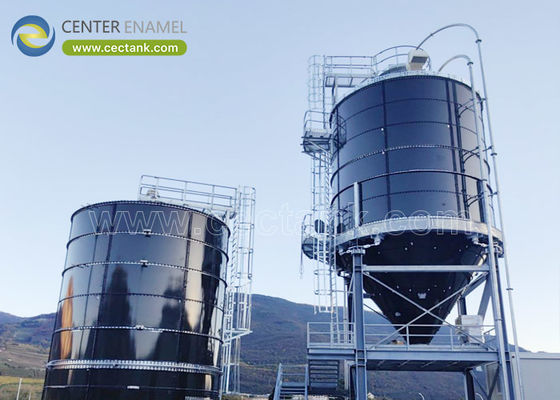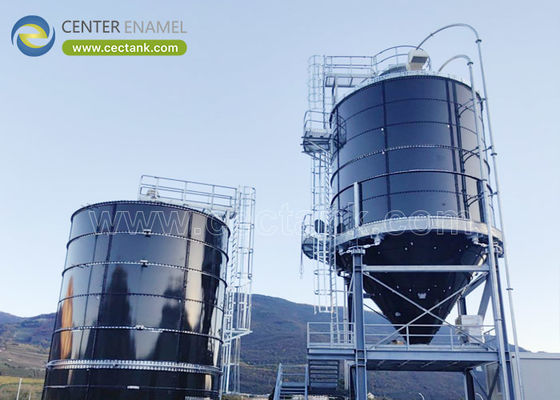-
Glas gesmolten met stalen tanks (419)
-
roestvrij staaltanks (372)
-
De fusie plakte Epoxytanks (424)
-
Gegalvaniseerde stalen tanks (321)
-
De Daken van de aluminiumkoepel (753)
-
Opbergtanks voor afvalwater (226)
-
gelaste stalen tanks (297)
-
Drukvaten (295)
-
Anaërobe Autoclaaf (201)
-
Industriële Watertanks (349)
-
Gelaagde stalen tanks (180)
-
Vastgeboute Staaltanks (181)
-
De Tank van de modderopslag (115)
-
De Tank van de biogasopslag (173)
-
Leachatopslagtanks (133)
-
Landbouwwateropslagtanks (179)
-
Brandwatertank (166)
-
Graanopslagplaatsen (130)
-
Biogas projecten (349)
-
Waterzuiveringsinstallatieprojecten (270)
-
Doppel membraan dak (177)
GFS-aërobe reactoren: een revolutie in de zuivering van afvalwater met duurzaamheid en efficiëntie
| Plaats van herkomst: | CHINA |
| Merknaam: | CEC TANKS |
| Certificering: | ISO 9001:2008, AWWA D103 , OSHA , BSCI |
| Modelnummer: | W201609013 |
| Min. bestelaantal: | 1Set |
| Prijs: | $5000~$20000 one set |
| Verpakking Details: | PE poly-foam tussen elke twee stalen platen; houten pallet en houten doos |
| Levertijd: | 0-60 dagen nadat de storting is ontvangen |
| Betalingscondities: | L/c, t/t |
| Levering vermogen: | 60 sets per maand |
|
Detailinformatie |
|||
Productbeschrijving
GFS-aërobe reactoren: een revolutie in de zuivering van afvalwater met duurzaamheid en efficiëntie
Een doeltreffende afvalwaterzuivering is wereldwijd een noodzaak geworden vanwege groeiende milieuproblemen en strengere regelgeving.Aërobe reactoren spelen een cruciale rol in moderne afvalwaterzuiveringsinstallaties doordat zij de biologische afbraak van organische verontreinigende stoffen via de activiteit van aërobe micro-organismen vergemakkelijkenOm de efficiëntie en duurzaamheid van deze systemen te waarborgen, zijn de constructie en de materialen van aerobe reactoren van het grootste belang.De Commissie heeft de Commissie verzocht om een verslag uit te brengen over de resultaten van de evaluatie van de resultaten van het onderzoek., corrosiebestendige en onderhoudsvriendelijke oplossingen die geschikt zijn voor diverse toepassingen voor afvalwaterzuivering over de hele wereld.
Als een toonaangevende fabrikant van opslagtanks wereldwijd kan Center Enamel voorzien van glasgelijnd staal (GLS) tanks, fusie gebonden epoxy tanks, roestvrij staal tanks,gegalvaniseerde stalen tanks en geodetische aluminiumkoepeldakken, afvalwater- en biogasprojectapparatuur voor wereldwijde klanten.
| Configuratie van aangepaste opslagtanks | ||||
| Verpakkingstanks | Volume. | Daken | Toepassing | Ontwerpvereisten |
|
GLS-tanks SS-tanks Epoxytankjes met fusiebonding Gegalvaniseerde stalen tanks Gelaste stalen tanks |
< 1000 m3 1000-10000 m3 10000 tot 200000 m3 20000-25000 m3 > 25000 m3 |
ADR-dak GLS-dak Membraandak FRP-dak Dekking van het dak |
Project afvalwaterzuivering Drinkwaterproject Gemeentelijk rioolproject Biogasproject Project voor brandwateropslag Olieopslagproject |
Watervoorziening en afvoer Seismisch ontwerp Windbestendig ontwerp Ontwerp voor bliksembescherming Ontwerp van de isolatie van de tank |
Levering van apparatuur voor afvalwaterzuiveringsprojecten
| Voorbehandelingstoestellen | Systemen voor hulpbronnengebruik | Slibbehandelingssysteem | Andere apparatuur |
|
Mechanische bar-scherm Vaste-vloeistofseparator Onderwatermixer |
Gashouder Boilersysteem Boost Fan Biografie Gasgenerator Torch systeem Ontwatering- en ontzwavelingstank |
PAM-integratie doseringsapparaat Schroefslib ontwateringsmachine Centrifuge voor het scheiden van slib |
Afvoerpomp Schroefmachine Onderwaterpomp voor rioolwater Driedimensionele scheider |
Inleiding tot aerobe reactoren bij afvalwaterzuivering
Aërobe biologische behandeling is gebaseerd op zuurstofafhankelijke micro-organismen om organische stoffen in afvalwater te metaboliseren.De aerobe reactor biedt een optimale omgeving voor deze biologische activiteit, waarbij zuurstof wordt geleverd (vaak via beluchtingsapparaten) en omstandigheden zoals temperatuur, pH en voedingsstoffen worden gecontroleerd.
De belangrijkste doelstellingen van aerobe reactoren zijn:
- Vermindering van de biochemische zuurstofbehoefte (BOD) en de chemische zuurstofbehoefte (COD).
- Verwijdering van gesuspendeerde vaste stoffen en organische verontreinigingen.
- Ontgifting en stabilisatie van afvalwater.
- Vergemakkelijking van de vorming van slib voor afzetting en verwijdering stroomafwaarts.
Gewone aërobe reactortypen zijn actief slibreactoren, druppelfilters, roterende biologische contactoren en sequentiebatchreactoren (SBR).
![]()
Waarom GFS-tanks voor aerobe reactoren?
De keuze van het bouwmateriaal voor aerobe reactoren heeft een aanzienlijke invloed op de betrouwbaarheid van de werking, de onderhoudskosten en de levensduur.Traditionele materialen zoals beton en koolstofstaal hebben inherente beperkingen: beton is gevoelig voor scheuren en chemische aanvallen; koolstofstaal corrodereert snel als gevolg van de ruwe, natte en zuurstofrijke omgeving.
De technologie van glas-staal-smelten (GFS) combineert de uitzonderlijke chemische weerstand van glas met de mechanische sterkte van staal.bij hoge temperaturen (~ 820 °C tot 930 °C) op het staaloppervlak gesmolten glazen glazen glazen glazen glazen glazen glazen glazen glazen glazen glazen glazen glazen glazen glazen glazen glazen glazen glazen glazen glazen glazen glazen glazen glazen glazen glazen glazen glazen glazen glazen glazen glazen glazen glazen glazen glazen glazen glazen glazen glazen glazen glazen glazen glazen glazen glazen glazen glazen glazen glazen glazen glazen glazen glazen glazen glazen glazen glazen glazen glazen glazen glazen glazen glazen glazen glazen glazen glazen glazen glazen glazen glazen glazen glazen glazen glazen glazen glazen glazen glazen glazen glazen glazen glazen glazen glazen glazen glazen glazen glazen glazen glazen glazen glazen glazen glazen glazen glazen glazen glazen glazen glazen glazen glazen glazen glazen glazen glazen glazen glazen glazen glazen glazen gla, waardoor een gladde, glasvormige coating ontstaat die permanent bindt.
Belangrijkste voordelen van GFS-tanks in aerobe reactoren
- Superieure Corrosion Resistance
Afvalwater bevat een mengsel van zuren, alkalis, sulfiden, chloriden en microbiële metabolieten die agressief standaardmaterialen aanvallen.chemisch inerte glascoating is bestand tegen corrosie in een breed pH-bereik, die de tanks beschermt tegen afbraak, lekken en besmetting.
- Mechanische sterkte en slagweerstand
De sterkte van het staal is zo sterk dat het grote volumes en drukschommelingen van aerobe reactoren kan dragen.terwijl de glazen coating de taaiheid niet in gevaar brengt.
- Een glad oppervlak voor hygiëne en efficiëntie
Het gladde, glazige oppervlak van de GFS-tanksinterieur vermindert de biofouling en de kleven van slib, waardoor een betere beluchting, minder onderhoud en een gemakkelijke reiniging mogelijk zijn, wat van cruciaal belang is bij biologische behandeling.
- Verlengde levensduur en minder onderhoud
GFS-tanks hebben vaak een levensduur van meer dan 30 jaar met minimaal onderhoud en zijn veel duurzamer dan epoxy-gecoate stalen of betonnen tanks die vaak moeten worden gerepareerd en opnieuw moeten worden gecoat.
- Modulaire en snelle installatie
De bouw van GFS-tanks met gespannen panelen maakt een efficiënte montage ter plaatse, een gemakkelijke reparatie, verhuizing of uitbreiding mogelijk zonder zwaar lassen, waardoor de installatietijd en -kosten aanzienlijk worden verminderd.
- Duurzaamheid van het milieu
De materialen zijn volledig recyclebaar; het lage onderhoud vermindert het chemische en hulpbronverbruik, in overeenstemming met de duurzame doelstellingen voor afvalwaterzuivering.
Certificeringen
De GFS-tanks van Center Enamel voldoen aan internationale normen zoals ISO 9001, AWWA D103-09, NSF/ANSI 61, EN1090, OSHA, WRAS en FM-certificeringen, die kwaliteit en veiligheid van wereldklasse garanderen.
![]()
Ontwerpkenmerken van GFS-aerobische reactoren met middelgrote emaille
Structurele integriteit
Aerobische reactoren vereisen robuuste ontwerpen om te kunnen voorzien van beluchtingsapparatuur, mengsystemen en schommelende belastingen.Centrale glazuur van GFS-aërobe reactoren zijn voorzien van dikke warmgewalste stalen substraten (meestal 5-10 mm) met een dubbelzijdige glazuurcoating die zowel interne als externe bescherming biedt.
Boltpanelen
De panelen zijn nauwkeurig vervaardigd, met emaille bekleed en met siliconen pakkingen gespannen om strakke, lekvrije afdichtingen te vormen die thermische uitbreidingen onderhouden en lekken of lekken voorkomen.
Luchting en mengintegratie
GFS-aërobe reactoren kunnen worden uitgerust met verschillende beluchters (diffuse lucht,Mechanische) en mixers met corrosiebestendige inwendige installaties die zorgen voor een optimale zuurstofverdeling en biomassasuspensie.
Configureerbare afmetingen en capaciteiten
Van kleine proefinstallaties tot grote gemeentelijke zuiveringsinstallaties, tanks kunnen worden aangepast van een paar kubieke meter tot meer dan 60.000 kubieke meter, aanpassing van de diameter en hoogte per site vereisten.
Toegankelijkheid en werking
Het glasoppervlak van het glazen glazen glazen glazen glazen glazen glazen glazen glazen glazen glazen glazen glazen glazen glazen glazen glazen glazen glazen glazen glazen glazen glazen glazen glazen glazen glazen glazen glazen glazen glazen
![]()
Productie-excellentie bij Center Enamel
Bewezen processen
De productie van Center Enamel® maakt gebruik van geautomatiseerde oppervlaktevoorbereiding, coating, branden in elektrische ovens en strenge kwaliteitscontroles.gladheid, en corrosiebestendigheid.
Kwaliteitscontrole en testen
- Test van chemische weerstand onder agressieve effluentcomposities.
- Meting van de laagdikte en de hechting.
- Sparkonderzoek op defecten van de coating.
- Evaluatie van de mechanische belasting en drukweerstand.
Onderzoek en innovatie
Met bijna 200 patenten en voortdurend onderzoek en ontwikkeling, verbetert Center Enamel continu de coatingformules en productieprocessen om de taaiheid, hechting en levensduur van keramisch glazuur te optimaliseren.
![]()
Toepassingen van GFS-aërobe reactoren
Stedelijke afvalwaterzuivering
Aerobe reactoren zijn essentieel voor secundaire behandeling, het verwijderen van organische ladingen na primaire sedimentatie.betrouwbare vaten die bestand zijn tegen chemische spanningen en jarenlang biologische activiteit behouden.
Industrieel afvalwaterzuivering
Chemische stoffen, oliehoudende residuen en complexe organische stoffen in industriële afvalstoffen vereisen corrosiebestendige reactoren.
Voedsel- en drankenindustrie
Strenge sanitaire en verontreinigingscontrole in fermentatie- en afvalstromen vereist hygiënische aerobe reactoren met gladde coatings, een ideaal gebruiksgeval voor GFS-technologie.
Biogas- en hernieuwbare energiecentrales
Aërobe voorbehandeling kan de organische ladingsbalans verbeteren vóór anaërobe vertering, door gebruik te maken van GFS-reactoren om de processtabiliteit en -tijd te optimaliseren.
![]()
Case studies die het succes van de GFS-aërobe reactor aantonen
- Hong Kong Municipal Plant:Center Enamel leverde meerdere grote GFS-aërobe reactoren voor het verwerken van groot volume stedelijk afvalwater, die gedurende 10 jaar minimale corrosie en onderhoud hebben aangetoond.
- Europese voedselverwerkingsfaciliteitGeïnstalleerde GFS-aërobe tanks met verbeterde hygiëne, vermindering van biofilmproblemen en reinigingstijd.
- Midden-Oosten industriële site:GFS-reactoren weerstaan zeer corrosief afvalwater met nul storingen, waardoor ze meer dan 20 jaar betrouwbaar zijn.
![]()
Milieueffecten en economische gevolgen
- GFS-reactoren verbeteren de levensduur en besparen vervangingskosten en arbeidskosten.
- Verkorte stilstandstijden vergroten de doorvoer van de installatie en verminderen de lekken van het afvalwater.
- Minimaal onderhoudschemische stoffen verminderen de ecologische voetafdruk.
- Een snellere installatie vermindert de koolstofvoetafdruk van het project.
![]()
Waarom partner met Center Enamel?
- Pionier in de industrie met meer dan 30 jaar productie van GFS-tanks.
- Uitgebreide ondersteuning, inclusief ontwerp, productie, logistiek en naverkoopservice.
- Wereldwijd bereik met succesvolle installaties op alle continenten.
- Verbintenis tot duurzaamheid en milieuvriendelijke technologieën.
![]()
De aerobische reactoren van Center Enamel's Glass-Fused-to-Steel vertegenwoordigen het hoogtepunt van de biologische behandeling van afvalwater.en operationele prestatiesDeze reactoren zijn cruciaal in de weg naar schoner water en duurzame industrie wereldwijd.
Kies Center Enamel voor GFS-aërobe reactoren en partner voor langdurige, efficiënte en milieuvriendelijke behandelingsoplossingen.




